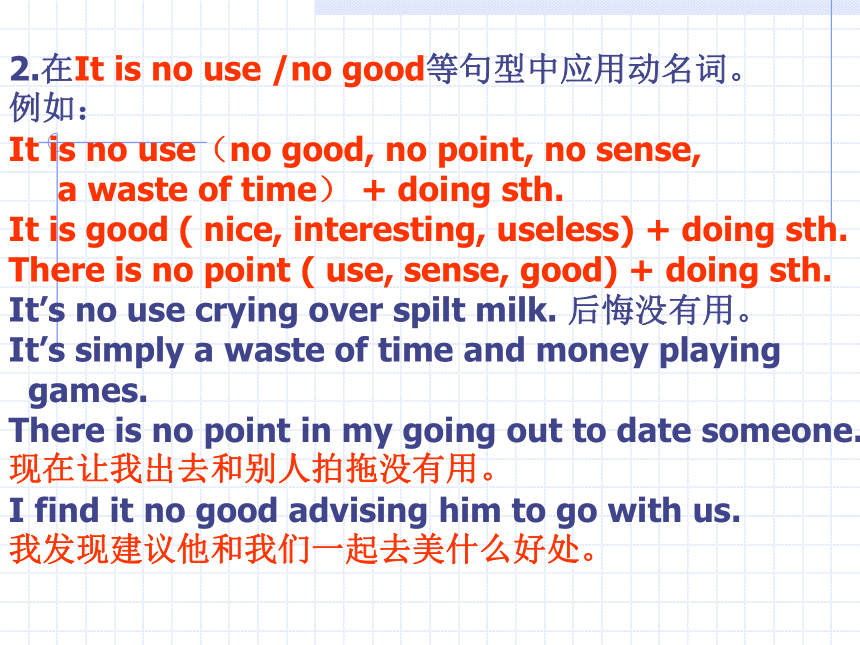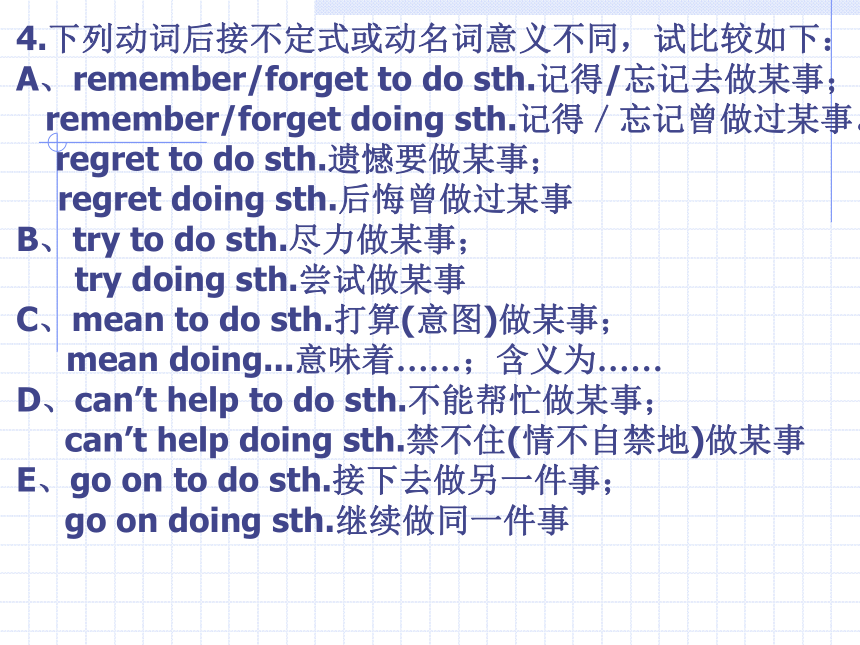英语语法系列复习专题八:非谓语动词
文档属性
| 名称 | 英语语法系列复习专题八:非谓语动词 |  | |
| 格式 | rar | ||
| 文件大小 | 18.6KB | ||
| 资源类型 | 教案 | ||
| 版本资源 | 人教版(新课程标准) | ||
| 科目 | 英语 | ||
| 更新时间 | 2010-02-09 17:03:00 | ||
图片预览









文档简介
(共21张PPT)
非谓语动词 非谓语动词是高中英语语法教学的重要内容之一,
也是教和学的一大难点。同时,还是高考每年必考的
内容之一。 一、作主语
非谓语动词包括动词不定式、动名词、分词 三种。
能够作主语的 是不定式和动名词。
1.动名词为泛指,表示抽象的、笼统的、习惯性的行为;
不定式则表示特指,指具体的、一次性的或尚未发生
的行为。 Collecting information is very important
to businessmen. To collect information is the most difficult job
for us to do next.
2.在It is no use /no good等句型中应用动名词。
例如:
It is no use(no good, no point, no sense,
a waste of time) + doing sth. It is good ( nice, interesting, useless) + doing sth. There is no point ( use, sense, good) + doing sth. It’s no use crying over spilt milk. 后悔没有用。 It’s simply a waste of time and money playing
games. There is no point in my going out to date someone.
现在让我出去和别人拍拖没有用。 I find it no good advising him to go with us.
我发现建议他和我们一起去美什么好处。
在“have difficulty ( trouble, problem, pleasure,
a difficult time (in) doing sth. 结构中,
后接动名词;
但注意 take the trouble to do sth. ,
have no time to do sth. 后接不定式.
I have some difficulty in persuading him.
I worked so late in the office last night
that I hardly had time to catch the last bus.
二、作表语 不定式、动名词、现在分词和过去分词均可用
作表语。
不定式与动名词作表语时的区别与作主语时相同。例如: My job is teaching English.
(泛指,多次性抽象行为) Your task is to go and help the farmers.
(特指,一次性具体行为) 同时,需要注意对等原则, 即:
表语使用不定式还是动名词应与主语保持一致。
例如: Seeing is believing .
To see is to believe.
不定式、动名词作表语时相当于名词,
而分词作表语时相当于形容词。现在分词表示主动,
过去分词表示被动。例如
One of the good exercises is climbing
the mountain.
(相当于名词,和主语表示同一概念,可与主语互换位置) The most difficult challenge is to live
without friends.
(相当于名词,表示具体的某项行为) English is interesting. I am interested in English. This news is exciting. The boys are excited at it. 两类分词作表语时,主要是看其与主语间的关系。
若主语为其动作的发出者,则用现在分词;
若主语为其动作的承受者,则用过去分词。
三、作宾语 不定式和动名词可用作宾语,两者在用法
上应注意以下几点: 1.通常只能接不定式作宾语的动词有:
agree,afford,arrange,choose,decide,
demand,expect,fail,hope,intend, manage,
offer,plan,pretend, promise,refuse,want
wish等。
例如: She failed to come to school yesterday. I can't afford to buy such an expensive
house.
2.通常只能接动名词作宾语的动词有:
allow,appreciate,avoid,consider,delay,
escape,excuse,enjoy,finish,imagine,
mind,keep, miss,
practise,suggest等。例如:
We can finish building the bridge
before the end of next month. Would you mind opening the window
注意:Advise,allow, forbid ,permit
这几个动词的特殊用法。
3.下列动词后接不定式或动名词作宾语意义无大区别:
like,love,prefer, hate,begin,start,continue, 等。 I hate to go /going swimming with her.
They continued to read /reading English. 但在下列情况下,宜用不定式,而不用动名词:
1)like,love,prefer,hate等与would或should连用时;
2)begin, start,continue等本身用的是进行体时;
3)begin, start,cease,continue等的主语为物而非人时;
4)后接know,understand,realize等心理活动的动词
表示一个逐渐演变的过程时。
4.下列动词后接不定式或动名词意义不同,试比较如下: A、remember/forget to do sth.记得/忘记去做某事;
remember/forget doing sth.记得/忘记曾做过某事。
regret to do sth.遗憾要做某事;
regret doing sth.后悔曾做过某事 B、try to do sth.尽力做某事;
try doing sth.尝试做某事 C、mean to do sth.打算(意图)做某事;
mean doing...意味着……;含义为…… D、can’t help to do sth.不能帮忙做某事;
can’t help doing sth.禁不住(情不自禁地)做某事 E、go on to do sth.接下去做另一件事;
go on doing sth.继续做同一件事
5.need,want,require等后接动名词时用主动形式,
为主动形式表被动意义。但后接不定式时应使用被动式。
例如:
The problem requires solving /to be solved
immediately.
6.不定式除可用在except,but,besides等后作宾语之外,
一般不用作介词宾语。此时,不定式能否省略to,
取决于其前是否有行为动词do或其相应形式。有则省略,
无则不能省略。例如: She did nothing but wash some clothes that day.
We had no choice except to walk home. 动名词则常用作介词的宾语。
例如:
She apologized to me for having broken
my glasses.
需要特别注意的是,动名词作介词to的宾语时,
极易与不定式结构混淆。
这类词组有:get down to,pay attention to,
look forward to,devote to ,stick to
be /get used to(习惯于,适应于),
lead to(导致)等。例如:
Let's get down to writing the agreement. Are you used to living in China
四、作宾补 不定式、现在分词、过去分词均可用作宾语补足语,
现予以比较如下: 1.用在see,hear,watch,notice等感官动词后作
宾补时,不定式常表示动作已结束,强调动作的全过程;
现在分词表示正在进行的动作,强调当时的情景,为部分
过程;过去分词则表示其与宾语之间为被动关系
或有该动作已完成的概念。例如: We heard her sing this song before we went in.
我们听她唱完这首歌才进去。 We heard her singing this song when we got there.
我们到达时,听见她在唱这首歌。 We often hear this song sung by her.
我们经常听见她唱这首歌。(歌是被唱)
2.用在have,get,leave(leave不能后接不定式作宾补)
等使役动词后作宾补时,不定式强调全过程,
现在分词强调进行的状态或持续状态,过去分词表示被动关系。
例如: Who can get this sick horse to eat (表示"吃下去") We tried our best,but still couldn't get the machine
running.(强调启动,进入工作状态) The farmers got the planting done before the rains came.
(被动,已完成) 3.用在with复合结构中,不定式表示尚未发生的将来动作,
现在分词表示主动关系,过去分词表示被动关系。例如 With a lot of work to do,I can't go to the film with
you tonight.(工作是"要做",还没有做) With the boy leading us the way,we had no difficulty
in finding her house.(主动关系,lead为男孩的动作) With homework done,Jim went out to play football.
(被动关系,作业是被做)
五、作定语 不定式、动名词、现在分词、过去分词均可作定语,可从
以下两个方面予以区别:1.位置不同。不定式多为后置定语,
动名词多为前置定语,单个的现在或过去分词作定语时一般
前置,分词短语作定语时则需后置。2.含义不同。不定式多
表示将来的动作,现在分词表示正在进行的动作或主动关系,
过去分词表示已完成的动作或被动关系。
动名词只能表示事物的属性、用途等。例如:
Take these sleeping pills and you'll sleep better.
(动名词表示用途,而the sleeping child中的sleeping
则为现在分词,为其"正在进行的"动作) Don't drink boiling water.Drink boiled water.
(boiling表示正进行,boiled表示已完成) Do you know the man talking with our maths teacher
(表示主动关系) I lost the calculator given by my uncle.(表示被动关系)
另外,不定式、现在分词作定语时也可使用其
被动式,
应注意它们此时与过去分词的区别。试比较如下: The problem to be discussed at tomorrow's
meeting(明天会上要讨论的问题)is how to
deal with the old building. The problem being discussed at the
meeting now(现在会上正讨论的问题)is how
to deal with the old building. The problem discussed at yesterday's
meeting(昨天会上讨论的问题)is how to
deal with the old building.
六、作状语 不定式作状语通常只能表示目的、结果;分词作状语
可表示 原因、时间、条件、方式、伴随状态、让步等。
试比较如下:
To be a good teacher,you must be strict with
yourself and in your work.(目的) We got there only to find that they had already
left. (结果) Not knowing the way,she stopped to ask
an old man.(原因) Having done all his homework,Li Lei turned
on his TV to watch the football match.(时间)
Given more time,we could have done the job
much better.(条件)
The girls walked home,talking and singing.(方式) Lying on the grass,he was thinking of his
childhood.(伴随状态) Beaten by the Japanese team,we are still in
high spirits.(让步)
但:
Given(if) the health,the thing can be done.
在以下情况下常使用不带(或省略)to的动词不定式: 1. 感官动词后面:feel, listen, hear, look at, notice,
see, watch, observe, perceive I saw a man enter the shop. 2. 个别表示使役意义的动词,如:have, let, make, The teacher has us write a composition
every week. 3. 一些情态动词,had better, would rather…than…,
would sooner…than…,rather than, may well do,may as well do (还是…好了),
can not but…,can not help but…等句型, Rather than wait anyone, I decided to go home
by taxi. We might as well put up here for tonight
4. 在do (did, does, done) nothing (anything,
everything ) but (except) do 句型中。 I can do nothing but follow your advice. 如果but或except之前没有do,help,
其后的to 不能省略。 There is no choice but to wait and see. 5. 由 all, what 引导的主语从句或者主语被only,
first, one, least 或形容词最高级修饰时,
而且从句中含有do时,
其表语如果是动词不定式,则往往省去to。 What I have to do is take a rest. The only thing I could do was do it myself.
6. 由并列连词and,except, but, than, or
连接两个以上的具有相同意义或功能的不定式时, 第二个动词不定式不带to。
I’d like to stay with you, help you
and learn from you. She told us to stay at home
and wait till she came back.
非谓语动词 非谓语动词是高中英语语法教学的重要内容之一,
也是教和学的一大难点。同时,还是高考每年必考的
内容之一。 一、作主语
非谓语动词包括动词不定式、动名词、分词 三种。
能够作主语的 是不定式和动名词。
1.动名词为泛指,表示抽象的、笼统的、习惯性的行为;
不定式则表示特指,指具体的、一次性的或尚未发生
的行为。 Collecting information is very important
to businessmen. To collect information is the most difficult job
for us to do next.
2.在It is no use /no good等句型中应用动名词。
例如:
It is no use(no good, no point, no sense,
a waste of time) + doing sth. It is good ( nice, interesting, useless) + doing sth. There is no point ( use, sense, good) + doing sth. It’s no use crying over spilt milk. 后悔没有用。 It’s simply a waste of time and money playing
games. There is no point in my going out to date someone.
现在让我出去和别人拍拖没有用。 I find it no good advising him to go with us.
我发现建议他和我们一起去美什么好处。
在“have difficulty ( trouble, problem, pleasure,
a difficult time (in) doing sth. 结构中,
后接动名词;
但注意 take the trouble to do sth. ,
have no time to do sth. 后接不定式.
I have some difficulty in persuading him.
I worked so late in the office last night
that I hardly had time to catch the last bus.
二、作表语 不定式、动名词、现在分词和过去分词均可用
作表语。
不定式与动名词作表语时的区别与作主语时相同。例如: My job is teaching English.
(泛指,多次性抽象行为) Your task is to go and help the farmers.
(特指,一次性具体行为) 同时,需要注意对等原则, 即:
表语使用不定式还是动名词应与主语保持一致。
例如: Seeing is believing .
To see is to believe.
不定式、动名词作表语时相当于名词,
而分词作表语时相当于形容词。现在分词表示主动,
过去分词表示被动。例如
One of the good exercises is climbing
the mountain.
(相当于名词,和主语表示同一概念,可与主语互换位置) The most difficult challenge is to live
without friends.
(相当于名词,表示具体的某项行为) English is interesting. I am interested in English. This news is exciting. The boys are excited at it. 两类分词作表语时,主要是看其与主语间的关系。
若主语为其动作的发出者,则用现在分词;
若主语为其动作的承受者,则用过去分词。
三、作宾语 不定式和动名词可用作宾语,两者在用法
上应注意以下几点: 1.通常只能接不定式作宾语的动词有:
agree,afford,arrange,choose,decide,
demand,expect,fail,hope,intend, manage,
offer,plan,pretend, promise,refuse,want
wish等。
例如: She failed to come to school yesterday. I can't afford to buy such an expensive
house.
2.通常只能接动名词作宾语的动词有:
allow,appreciate,avoid,consider,delay,
escape,excuse,enjoy,finish,imagine,
mind,keep, miss,
practise,suggest等。例如:
We can finish building the bridge
before the end of next month. Would you mind opening the window
注意:Advise,allow, forbid ,permit
这几个动词的特殊用法。
3.下列动词后接不定式或动名词作宾语意义无大区别:
like,love,prefer, hate,begin,start,continue, 等。 I hate to go /going swimming with her.
They continued to read /reading English. 但在下列情况下,宜用不定式,而不用动名词:
1)like,love,prefer,hate等与would或should连用时;
2)begin, start,continue等本身用的是进行体时;
3)begin, start,cease,continue等的主语为物而非人时;
4)后接know,understand,realize等心理活动的动词
表示一个逐渐演变的过程时。
4.下列动词后接不定式或动名词意义不同,试比较如下: A、remember/forget to do sth.记得/忘记去做某事;
remember/forget doing sth.记得/忘记曾做过某事。
regret to do sth.遗憾要做某事;
regret doing sth.后悔曾做过某事 B、try to do sth.尽力做某事;
try doing sth.尝试做某事 C、mean to do sth.打算(意图)做某事;
mean doing...意味着……;含义为…… D、can’t help to do sth.不能帮忙做某事;
can’t help doing sth.禁不住(情不自禁地)做某事 E、go on to do sth.接下去做另一件事;
go on doing sth.继续做同一件事
5.need,want,require等后接动名词时用主动形式,
为主动形式表被动意义。但后接不定式时应使用被动式。
例如:
The problem requires solving /to be solved
immediately.
6.不定式除可用在except,but,besides等后作宾语之外,
一般不用作介词宾语。此时,不定式能否省略to,
取决于其前是否有行为动词do或其相应形式。有则省略,
无则不能省略。例如: She did nothing but wash some clothes that day.
We had no choice except to walk home. 动名词则常用作介词的宾语。
例如:
She apologized to me for having broken
my glasses.
需要特别注意的是,动名词作介词to的宾语时,
极易与不定式结构混淆。
这类词组有:get down to,pay attention to,
look forward to,devote to ,stick to
be /get used to(习惯于,适应于),
lead to(导致)等。例如:
Let's get down to writing the agreement. Are you used to living in China
四、作宾补 不定式、现在分词、过去分词均可用作宾语补足语,
现予以比较如下: 1.用在see,hear,watch,notice等感官动词后作
宾补时,不定式常表示动作已结束,强调动作的全过程;
现在分词表示正在进行的动作,强调当时的情景,为部分
过程;过去分词则表示其与宾语之间为被动关系
或有该动作已完成的概念。例如: We heard her sing this song before we went in.
我们听她唱完这首歌才进去。 We heard her singing this song when we got there.
我们到达时,听见她在唱这首歌。 We often hear this song sung by her.
我们经常听见她唱这首歌。(歌是被唱)
2.用在have,get,leave(leave不能后接不定式作宾补)
等使役动词后作宾补时,不定式强调全过程,
现在分词强调进行的状态或持续状态,过去分词表示被动关系。
例如: Who can get this sick horse to eat (表示"吃下去") We tried our best,but still couldn't get the machine
running.(强调启动,进入工作状态) The farmers got the planting done before the rains came.
(被动,已完成) 3.用在with复合结构中,不定式表示尚未发生的将来动作,
现在分词表示主动关系,过去分词表示被动关系。例如 With a lot of work to do,I can't go to the film with
you tonight.(工作是"要做",还没有做) With the boy leading us the way,we had no difficulty
in finding her house.(主动关系,lead为男孩的动作) With homework done,Jim went out to play football.
(被动关系,作业是被做)
五、作定语 不定式、动名词、现在分词、过去分词均可作定语,可从
以下两个方面予以区别:1.位置不同。不定式多为后置定语,
动名词多为前置定语,单个的现在或过去分词作定语时一般
前置,分词短语作定语时则需后置。2.含义不同。不定式多
表示将来的动作,现在分词表示正在进行的动作或主动关系,
过去分词表示已完成的动作或被动关系。
动名词只能表示事物的属性、用途等。例如:
Take these sleeping pills and you'll sleep better.
(动名词表示用途,而the sleeping child中的sleeping
则为现在分词,为其"正在进行的"动作) Don't drink boiling water.Drink boiled water.
(boiling表示正进行,boiled表示已完成) Do you know the man talking with our maths teacher
(表示主动关系) I lost the calculator given by my uncle.(表示被动关系)
另外,不定式、现在分词作定语时也可使用其
被动式,
应注意它们此时与过去分词的区别。试比较如下: The problem to be discussed at tomorrow's
meeting(明天会上要讨论的问题)is how to
deal with the old building. The problem being discussed at the
meeting now(现在会上正讨论的问题)is how
to deal with the old building. The problem discussed at yesterday's
meeting(昨天会上讨论的问题)is how to
deal with the old building.
六、作状语 不定式作状语通常只能表示目的、结果;分词作状语
可表示 原因、时间、条件、方式、伴随状态、让步等。
试比较如下:
To be a good teacher,you must be strict with
yourself and in your work.(目的) We got there only to find that they had already
left. (结果) Not knowing the way,she stopped to ask
an old man.(原因) Having done all his homework,Li Lei turned
on his TV to watch the football match.(时间)
Given more time,we could have done the job
much better.(条件)
The girls walked home,talking and singing.(方式) Lying on the grass,he was thinking of his
childhood.(伴随状态) Beaten by the Japanese team,we are still in
high spirits.(让步)
但:
Given(if) the health,the thing can be done.
在以下情况下常使用不带(或省略)to的动词不定式: 1. 感官动词后面:feel, listen, hear, look at, notice,
see, watch, observe, perceive I saw a man enter the shop. 2. 个别表示使役意义的动词,如:have, let, make, The teacher has us write a composition
every week. 3. 一些情态动词,had better, would rather…than…,
would sooner…than…,rather than, may well do,may as well do (还是…好了),
can not but…,can not help but…等句型, Rather than wait anyone, I decided to go home
by taxi. We might as well put up here for tonight
4. 在do (did, does, done) nothing (anything,
everything ) but (except) do 句型中。 I can do nothing but follow your advice. 如果but或except之前没有do,help,
其后的to 不能省略。 There is no choice but to wait and see. 5. 由 all, what 引导的主语从句或者主语被only,
first, one, least 或形容词最高级修饰时,
而且从句中含有do时,
其表语如果是动词不定式,则往往省去to。 What I have to do is take a rest. The only thing I could do was do it myself.
6. 由并列连词and,except, but, than, or
连接两个以上的具有相同意义或功能的不定式时, 第二个动词不定式不带to。
I’d like to stay with you, help you
and learn from you. She told us to stay at home
and wait till she came back.
